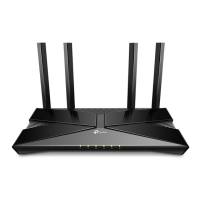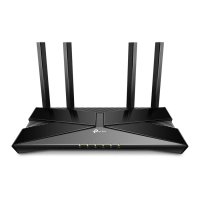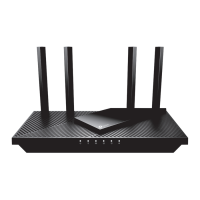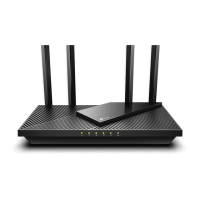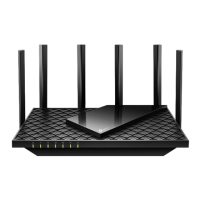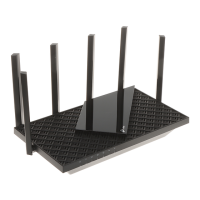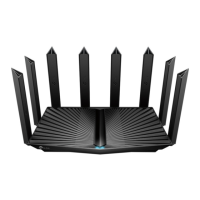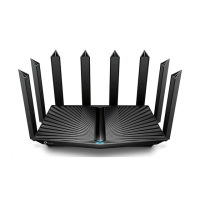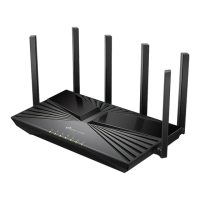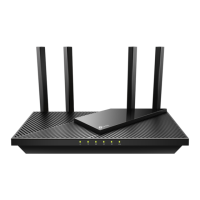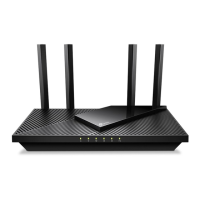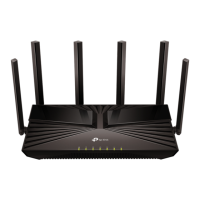Do you have a question about the TP-Link Archer AX23V and is the answer not in the manual?
Introduces the router's features, technology, and ease of use.
Details the physical appearance of the router, including LED indicators.
Provides guidelines for optimal router placement to ensure proper function and safety.
Step-by-step instructions for connecting the router to your modem and power source.
Walkthrough for setting up the internet connection using the router's wizard.
Instructions for configuring the router using the TP-Link Tether mobile application.
Detailed steps for manually configuring various internet connection types.
Steps to configure the router to function as an access point for extending Wi-Fi.
Guide for setting up an internet connection using the IPv6 protocol.
Explains how to create a TP-Link ID for cloud services and remote management.
Instructions for modifying the email address and password associated with your TP-Link ID.
Details on adding and removing TP-Link IDs for managing the router.
How to use the Tether app for managing the router remotely.
Customizing Wi-Fi network name (SSID), password, and security options.
How to set a schedule for the wireless network to automatically turn on/off.
Explains how to use Wi-Fi Protected Setup (WPS) for easy connection.
Configuration of advanced wireless parameters like WMM, AP Isolation, and Airtime Fairness.
Setting up a dedicated wireless network for Internet of Things devices.
Steps to create a separate Wi-Fi network for guests.
Options for customizing guest network security and access permissions.
How to set up restrictions on internet access for specific devices and users.
Tools for monitoring and managing internet usage by family members.
How to add another TP-Link router to create an EasyMesh network.
Steps to add a range extender to the EasyMesh network.
How to view and manage devices within the EasyMesh network.
Using the SPI Firewall to protect the network from unauthorized access and threats.
Blocking or allowing specific devices to access the network using MAC addresses.
Binding IP addresses to MAC addresses to prevent ARP spoofing.
Application Layer Gateway settings to support NAT traversal for various protocols.
Isolating devices to protect the network from potential security threats.
Configuring port forwarding to allow external access to local network services.
Setting up port triggering for applications that require dynamic port opening.
Using DMZ to expose a device to the internet for unrestricted communication.
Enabling UPnP to allow applications like online games to open ports automatically.
Setting up an OpenVPN server on the router for secure remote access.
Configuring a PPTP VPN server for remote access to the home network.
Modifying the router's LAN IP address and subnet mask.
Setting up the router for IPTV services, including IGMP proxy and VLAN.
Configuring the DHCP server to assign IP addresses and reserve them for specific devices.
Configuring DDNS to access the router remotely using a domain name.
Manually configuring routing entries to direct network traffic.
Instructions for updating the router's firmware via online or local methods.
Backing up and restoring router configuration settings for future use or recovery.
Changing the router's web management login password.
Setting up a password recovery mechanism for the router login.
Limiting access to the router's management interface based on MAC addresses.
Enabling and configuring remote access to the router's management interface.
Viewing and saving system logs for troubleshooting network issues.
Using diagnostic tools like Ping and Traceroute to test network connectivity.
Configuring the router's system time and display language.
Scheduling regular reboots to maintain router performance.
Configuring the router's LED indicators, including a night mode.
| Brand | TP-Link |
|---|---|
| Model | Archer AX23V |
| Category | Wireless Router |
| Language | English |
